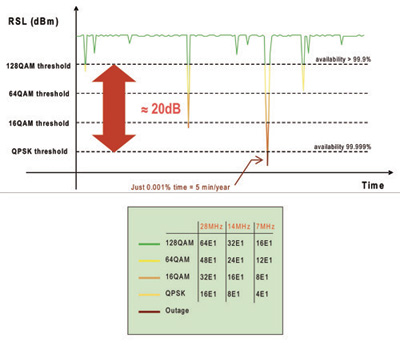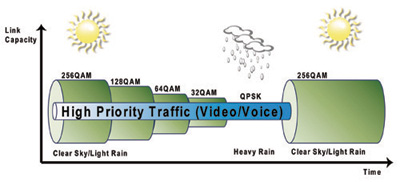Much has been written about the benefits of personal broadband, or the mobile Internet — the ability to have broadband services wherever and whenever you are. The challenge that this places on the network operators is to deliver increased bandwidth needed for such services at prices comparable to today’s average revenue per user (ARPU) . The result is the need to achieve costs that approach 10 percent of the cost per bit achieved by legacy solutions. The challenge to do this is placed squarely on the technologists and network designers of the new networks.
The goal of technologists is combine new technologies and network design principles for the delivery of performance/cost benefits greater than that delivered by the individual parts. The intersection of adaptive modulation, Ethernet microwave and ring/mesh architectures is an example of such a combination. The combination of these elements can double the effective capacity; while at the same time reduce the antenna lease cost by a factor of two, resulting in a 25 to 30 percent reduction in the total cost of ownership (TCO).
Adaptive modulation is the ability of a radio link to change the modulation state to adapt to varying link conditions and maximize the throughput at any point in time. This technology was originally developed in license-exempt radios as a means to combat interference or multipath reflections. It has recently been applied in point-to-point microwave systems to combat rain fades (the principal cause of link failures).
The engineering of a point-to-point microwave link is traditionally accomplished to ensure a target availability percentage — e.g. 99.999 percent. In order to achieve this, the antenna size, channel size, output power and modulation index are selected to deliver the desired capacity under the worst case atmospheric conditions that only occur 0.001 percent of the time. The rest of the time, the system is capable of performing at higher throughputs, or operating with smaller antennas or smaller channel size. Adaptive modulation allows the system to increase the modulation index, output power and even perhaps the forward error correction coding to increase the capacity during normal conditions, giving the operator access to up to four times the bandwidth during normal conditions.

For traditional TDM-based microwave systems a feature like adaptive modulation is of little interest. An OC3 radio is either transmitting the entire capacity, or nothing. Ethernet, on the other hand, is designed to handle varying throughput, oversubscription and enforce quality of service to make sure that the high priority traffic makes it through even in the presence of congestion on the link. When coupled with adaptive modulation, Ethernet radios can take advantage of the high capacity available during normal operation and still guarantee the 99.999 percent availability to the high priority traffic.

When network planners consider these new capabilities, they are able to design networks that can take advantage of the characteristics already discussed to gain further advantages. For example, traditional microwave networks are designed with 1+1 systems for redundancy. These share the same path, so failures in the over air propagation due to rain fades are combined with equipment failures in determining the link availability. An alternative topology is the ring or mesh architecture, where there are at least two links out of each node, each with a different path.
Normally the designer must reserve the same amount of bandwidth on the protection path out of the node as he/she allocates to the working side — i.e. 50 percent of the bandwidth sits idle when there are no failures in the network. Now the designer can take advantage of the fact that the rain fade events and the equipment failures are not correlated with each other. This allows him/her to use the bandwidth on all paths out of the node for revenue-generating traffic and to rely on the adaptive modulation to provide excess capacity on the surviving link in the event of an equipment failure. In the event of a rain fade on a given link, both links will still be working and it is possible to deliver all of the high-priority traffic. This combination of adaptive capacity and path diversity effectively doubles the capacity utilization (or cuts the network cost in half).
An alternative way to consider this is to look at the antenna size impact on the overall network cost. Typically the antenna lease is proportional to the size of the antenna. Adaptive modulation can deliver more than 20 dB of link gain improvement – allowing the user to reduce the antenna size by at least a factor of two, reducing the antenna lease costs by a similar amount. Since the antenna lease cost can make up 40 percent of TCO, this can result in a 20 percent reduction in the TCO — more than the total capital cost of the radios contribute to the TCO.
Next generation services, which demand an order of magnitude more bandwidth at the same or lower backhaul costs, require this sort of innovation in order to have a sustainable business case. This requires a willingness by the network operators to embrace change and new ways of designing networks — typically a very difficult thing to do, especially in large established organizations. Simply doing the same thing the same way will not achieve the results that are required.
The good news is that significant reductions not only in capital costs, but network efficiency and total cost of ownership are possible through the synergistic application of technology advances and network design. The combination of Ethernet microwave, Adaptive modulation and ring/mesh architectures is one such example that can significantly improve the viability of the next generation of mobile services.
Don’t forget to check out TMCnet’s White Paper Library, which provides a selection of in-depth information on relevant topics affecting the IP Communications industry. The library offers white papers, case studies and other documents which are free to registered users.
Dr. Alan Solheim, Vice President of Product Management at DragonWave, is author of TMCnet’s The Middle Mile column. To read more of Alan’s articles, please visit his columnist page.
Edited by Mae Kowalke
 Internet Telephony Magazine
Click here to read latest issue
Internet Telephony Magazine
Click here to read latest issue CUSTOMER
CUSTOMER  Cloud Computing Magazine
Click here to read latest issue
Cloud Computing Magazine
Click here to read latest issue IoT EVOLUTION MAGAZINE
IoT EVOLUTION MAGAZINE




